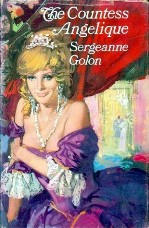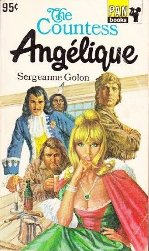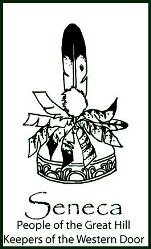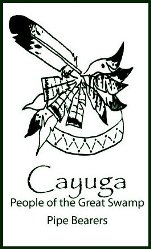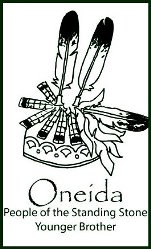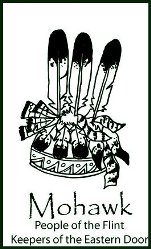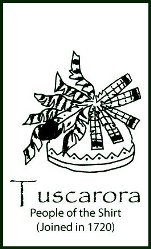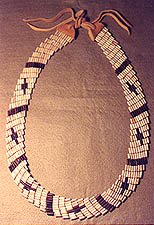Countess Angélique
 The original and authentic title for this book is 'Angélique et le Noveau Monde' which in translation reads 'Angélique and the New World' - not 'Angélique in the New World'. The hardback version of the English translation shows a louche woman with a self-satisfied smirk, inappropriately covered in and glittering with precious jewels and fine materials only just this side of decently covering her decolletage. Could this be
The original and authentic title for this book is 'Angélique et le Noveau Monde' which in translation reads 'Angélique and the New World' - not 'Angélique in the New World'. The hardback version of the English translation shows a louche woman with a self-satisfied smirk, inappropriately covered in and glittering with precious jewels and fine materials only just this side of decently covering her decolletage. Could this be the same woman who has just stepped off a ship that has undergone an arduous ocean crossing where food had become scarce; fresh fruit, vegetables and milk no longer available in the latter parts of the voyage and who, with a mother's instinct to sustain her starving child, fed her her own rations ... A woman who has been newly presented to the passengers and crew as the wife of the Count of Toulouse and dressed accordingly to acknowledge her rank and to establish their personal relationship in this instant of arriving in the New World. Dressed in beautiful clothing as an antithesis to the servants clothing they were all accustomed to and which would have been alien to them as well as to her in this situation ... A woman who was about to become a pioneer amongst them and join their fight for survival against the alien conditions confronting them, helping to build a community and the housing they would share, becoming a healer, shredding her hands and nails preparing herbs and roots .... just who is this woman on the cover of the English hardback versions supposed to be?
the same woman who has just stepped off a ship that has undergone an arduous ocean crossing where food had become scarce; fresh fruit, vegetables and milk no longer available in the latter parts of the voyage and who, with a mother's instinct to sustain her starving child, fed her her own rations ... A woman who has been newly presented to the passengers and crew as the wife of the Count of Toulouse and dressed accordingly to acknowledge her rank and to establish their personal relationship in this instant of arriving in the New World. Dressed in beautiful clothing as an antithesis to the servants clothing they were all accustomed to and which would have been alien to them as well as to her in this situation ... A woman who was about to become a pioneer amongst them and join their fight for survival against the alien conditions confronting them, helping to build a community and the housing they would share, becoming a healer, shredding her hands and nails preparing herbs and roots .... just who is this woman on the cover of the English hardback versions supposed to be?
I believe that there could be several reasons for this, chiefly that the artist had been given a title and never looked beyond the title page. I much prefer the French version shown above and the eventual English paperback versions which were published twice and on both cover printings the images represented the pioneering spirit of the storyline (and some more decolletage of course!).
Although I started reading these books several years after they were first published in the English language, their popularity was such that they always seemed to be on the bookshelves in the shops and in the libraries. The versions of the original 6 books that I owned were Pan (paperback) reprints - in this case the 9th dated 1966. I would have been reading avidly at this time and it was a long wait until 1969 when the Pan version of 'Countess' first appeared in my favourite bookshops.
The delay in purchases on my part were two or three fold - I could not afford hardbacks at the time and would not have searched for them at W H Smith (I stopped going to Sisson and Parkers once the Victoria Centre had opened) which was a paperback realm. I was too busy to go to the library and anyway, to all intents and purposes, there was little or no indication in the English translation of 'Angélique in Love' that the series was likely to continue - after all, everything had been rounded off so nicely - all the major characters were safe and reunited, we had heard 'Rescator's Story' on the long voyage over the sea, peace had broken out amongst the pirates and the Huguenots and a 'Brave New World' with all its riches and opportunities awaited everyone.
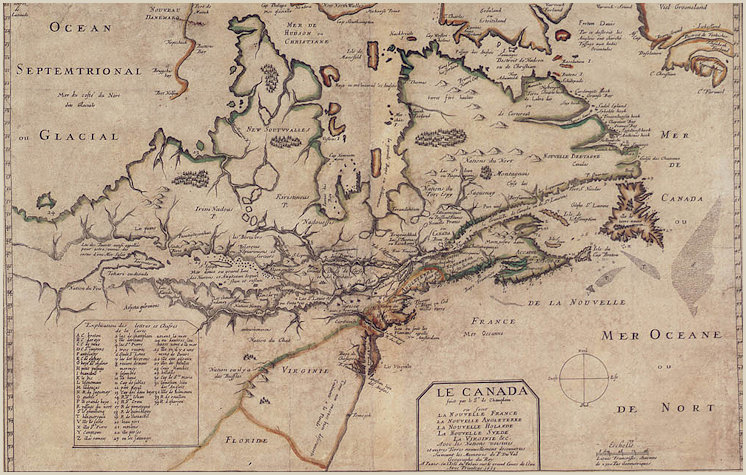
1653 Cartographer's map of 'Le Canada' at around the time of the Peyracs arrival in the New World - image sourced from : sec4history.wordpress.com
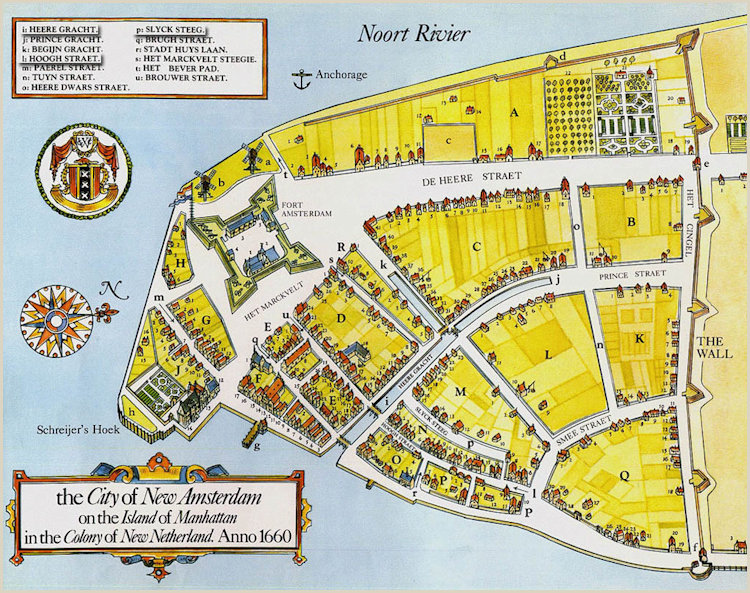
As the main port of New Amsterdam (from 1660)/New York/Manhattan Island grew and flourished and changed hands it is likely to have been very similar to the map above by the time the Peyracs landed and awaited the ships bringing news, letters (personal and of patent) and other circulars and literature by ship from the old world to the new. - Image sourced from vandervaartenomstreken.nl via newamsterdamhistorycenter
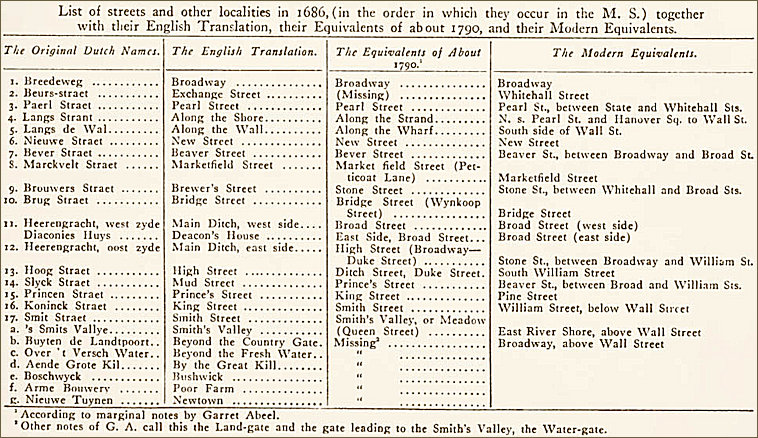
An interesting exercise comparing the original street names with their English equivalent of the time and as currently known and instantly recognisable. - Image sourced from vandervaartenomstreken.nl
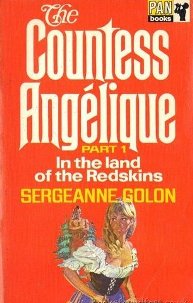 So, it was a bit of a surprise when one day I spotted a book called 'Countess Angélique' in an orange cover at Smiths - not in a prominent place, just on one of those revolving towers. I looked at the lettering first of all (I am very 'tactile' visually if you see what I mean) - it wasn't the same as the previous six books with which I was so familiar (and if the truth be told a little in love with the artists impression of the eponymous heroine). Then I looked at the cover with a certain degree of distaste as I really do not like the colour orange and noticed that it was Part 1 of the book. I looked at the image of the woman on the front - there was a passing resemblance to the image on the front cover of 'Angélique in Revolt'. I had a look at the authors name and that matched and then I read the back cover which indicated that this was, indeed a sequel to 'Angélique in Love'. Luckily Part 2 in a purple cover was also available
So, it was a bit of a surprise when one day I spotted a book called 'Countess Angélique' in an orange cover at Smiths - not in a prominent place, just on one of those revolving towers. I looked at the lettering first of all (I am very 'tactile' visually if you see what I mean) - it wasn't the same as the previous six books with which I was so familiar (and if the truth be told a little in love with the artists impression of the eponymous heroine). Then I looked at the cover with a certain degree of distaste as I really do not like the colour orange and noticed that it was Part 1 of the book. I looked at the image of the woman on the front - there was a passing resemblance to the image on the front cover of 'Angélique in Revolt'. I had a look at the authors name and that matched and then I read the back cover which indicated that this was, indeed a sequel to 'Angélique in Love'. Luckily Part 2 in a purple cover was also available  so with a mounting sense of excitement I bought both books and couldn't wait to tell my sister about them - after all she had introduced me to Angélique in the first place. (I do just need to stress here that the sub-heading titles of the books leave much to be desired and will have been foisted on the author's original by either the translator or publisher or both! Book one, in particular, has caused a lot of offence in the late 20th and early 21st centuries.)
so with a mounting sense of excitement I bought both books and couldn't wait to tell my sister about them - after all she had introduced me to Angélique in the first place. (I do just need to stress here that the sub-heading titles of the books leave much to be desired and will have been foisted on the author's original by either the translator or publisher or both! Book one, in particular, has caused a lot of offence in the late 20th and early 21st centuries.)
By the way, my sister then confessed that she had seen the book at the library but had dismissed it thinking it was just a coincidence in the title. (One of these days I shall exact revenge on her for keeping me from this sequel - only kidding!)
In fact, I think that if I had seen the hardcover I would have dismissed it as well - the woman in that picture bedecked in jewels (as befitting a Countess) and sumptuous 'stuffs' (I love that antiquated word for materials) was smirking in the most self-satisfied way. What were the publishers thinking of? I'm guessing that, having committed to continue 'commissioning translations' and publishing the series they may have felt that if they did not portray 'Angélique' in a sultry and sumptuous way readers might be turned off by seeing her dressed in fustian and skins (I resist saying 'furs' as these were popular in the courts of Europe and were a great part of the trade between the Old and New Worlds but the pioneers will have used the skins as a necessity not as a fashion accessory). Could the publishers have been right? I admit that this is exactly what happened to me when I first started reading the book - I hated the New World experience - this couldn't be happening - when would we get back to the comfort of old Europe - this couldn't last surely? It was too much like our Girl Guide camping holidays - I never want to smell damp grass inside a tent ever again!
I have, since that time, revised my opinions of this second 'tranche' of books, but it took persistent re-reading of the whole series each time a new book came out to start appreciating the magic and the sheer 'cheek' of the authors to move the characters (and by extension us, the readers) to a completely different location and circumstances whilst retaining the same 'stock' characters.
Going back to my original debate then, did the publishers take fright at the content and commission the cover to reel readers in expecting a return to Court? Did the artist*, perhaps have no concept of the content and just thought 'French, Versailles and of course the wholly inappropriate "erotica" tag' applied to the books to produce this cover? Or was it something deliberately created to mislead the public? I don't know the answers to this - but it is strange that the sequel to a hugely popular series was treated with a degree of contempt in such a low key advertising campaign. * In 2019 with the help of Tim at Tikit I discovered that the illustrator of these covers was Hans Helweg - if you take a look at his working drawings you will appreciate that he did put a lot into them, the publishers once more kiboshed any hopes of an enticing cover ......
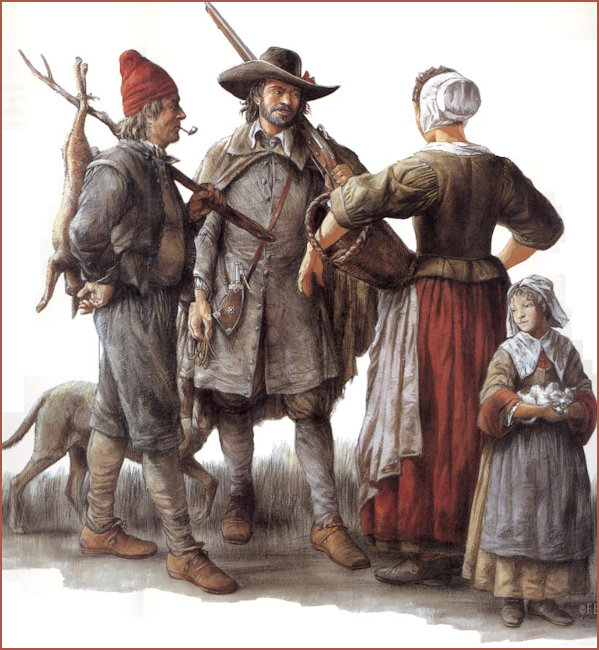
Even with redeeming the book covers intentions (see above), they are still a far cry from the type of clothing those moving from the Old World to the New would have been prepared for. Image sourced from: rd.uqam.ca

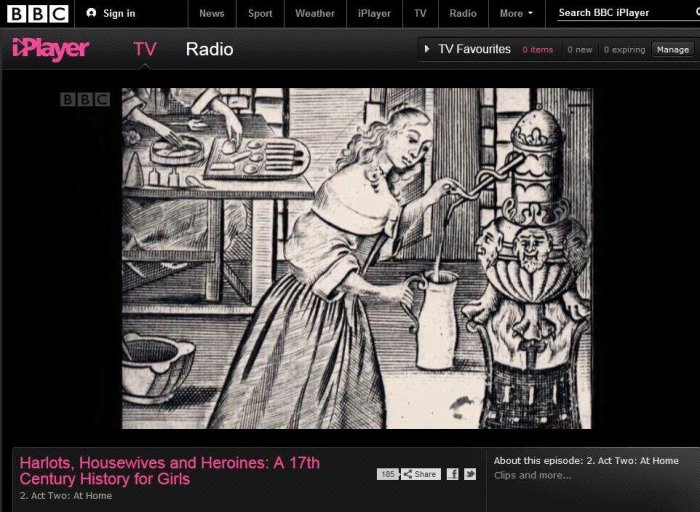
Recently the BBC screened a three-part series provocatively entitled “Harlots, Housewives and Heroines – A 17th Century History for Girls.” Needless to say it leaned heavily towards the English perspective with some reference to France (Charles II having returned from exile there) but generally, life in Europe would have been reflected in a similar manner. I was particularly struck by the illustration shown here (origins unknown) which show the woman as the manager of the household which included having to organise everything including ministering to the sick making her own medicines from herbs. The programme even went so far as to reproduce what had been made remarking on the fact that many of the herbs used in the 17th century were still being used today for the same symptoms and ailments. I was particularly drawn to this image imagining Angélique creating her potions in the fortress at Wapassou.

In some of the books, I sometimes get overwhelmed by one aspect within it which clouds the other really interesting areas of the book because that particular aspect sits at the forefront of my mind and makes me slide too quickly over some of the other, often, complex situations. In 'Angélique and the Sultan' despite it taking up less than a third of the book, the overriding aspect was the flight across the desert - in 'Countess Angélique' it is the question of Wampum and its significance to the plot, the storyline and its impact on the cultural history of the North American lifestyle.
I will happily admit to wondering what the fuss about Wampum was all about and then I researched it for my own peace of mind. For me, now, Wampum is the best thing since sliced bread and that is why it will form the remainder of this section (follow link) to compliment the storyline which Anne Golon brought to us in 'Angélique and the New World.'
Huron Territory
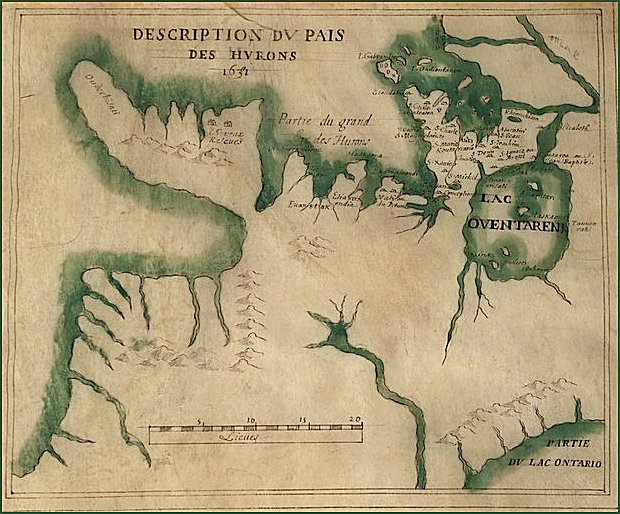
Map of Huron Country 1631–51
This important manuscript map on vellum depicts part of present-day Ontario, Canada, extending from Georgian Bay in the north (Partie du Grand Lac des Hurons) to Lake Ontario in the south, and from Lake Huron in the west to Lake Simcoe in the east (Lac Oventarenk). The map originally was dated 1631, but the date later was changed to 1651. Canadian scholar Conrad E. Heidenreich concluded that the main part of the map probably was drawn between 1639 and 1648, with slight revisions made after 1650, which most likely explains the change from 1631 to 1651. Heidenreich also surmised that the map, which is unsigned, was drawn by Saint Jean de Brébeuf (1593–1649). The map evidently was made to illustrate the location of Indian tribes and Jesuit missions, particularly in the area between Lake Simcoe and Georgian Bay. Brébeuf was born in Normandy, France, and joined the Jesuit order in 1617. In 1626 he established the first mission among the Huron Indians. He was captured by the Iroquois, enemies of the Hurons, then tortured and burned to death on March 16, 1649. He was canonized in 1930. Source: World Digital Library
Wampum
In addition to the appreciation of Wampum, must first come an appreciation of the Iroquois 5-Nation tribes which will feature prominently throughout the New World adventure that spans the book until the conclusion of 'La Victoire d'Angélique.' Here is a simplified map of their territories:
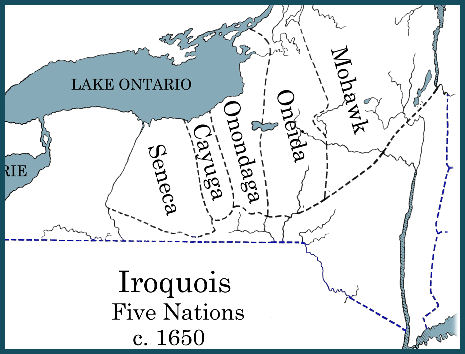
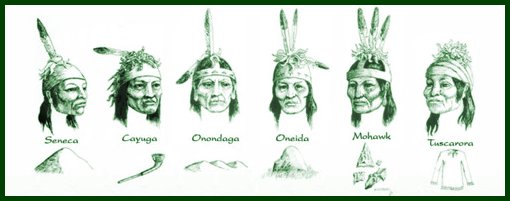
The people of the Five (Six) Nations, also known by the French term, Iroquois Confederacy, call themselves the Hau de no sau nee (ho dee noe sho nee) meaning People Building a Long House. Located in the northeastern region of North America, originally the Six Nations was five and included the Mohawks, Oneidas, Onondagas, Cayugas, and Senecas. The sixth nation, the Tuscaroras, migrated into Iroquois country in the early eighteenth century. Together these peoples comprise the oldest living participatory democracy on earth. Their story, and governance truly based on the consent of the governed, contains a great deal of life-promoting intelligence for those of us not familiar with this area of American history. The original United States representative democracy, fashioned by such central authors as Benjamin Franklin and Thomas Jefferson, drew much inspiration from this confederacy of nations. In our present day, we can benefit immensely, in our quest to establish anew a government truly dedicated to all life's liberty and happiness much as has been practiced by the Six Nations for over 800 hundred years.
At the end of this feature I will reproduce the design history of the Native American $1 coin which refers to the Great Tree of Peace, the Hiawatha Belt which is made of Wampum and the French and English settlers - all of which feature in the Angélique books set in the New World.

French-Iroquois Treaty of 1667
The Five Nations Confederacy would not remain in command on the north shore of Lake Ontario forever (or even all that long).
In the later 1660s the French began taking their own aggressive actions to restrain, among other things, the flow of furs from the north-shore Iroquois trading villages to the new English (and surviving old Dutch) traders and merchants at Albany and New York – as opposed to the French themselves at Quebec City and Montreal.
The first French step in what quickly enough unfolded as a quite systematic strategy was to strike a blow against the Five Nations’ military might (already weakened by the ongoing struggle with the Susquehannocks to the south, at the edge of the rising English Mid-Atlantic colonies). In 1665 French imperial officials sent a military force known as the Carignan-Salieres regiment off into the wilderness of “Canada or New France.”
Then, as the historical geographer Victor Konrad has explained: “In the spring of 1666, the Viceroy and the Governor of Canada, with 28 companies of foot and all the militia of the colony, marched into the country of the Mohawks” [the most easterly of the Five Nations Iroquois].
The vaunted military might of the King Louis XIV had some trouble adjusting to the rugged lakes and forest of northeastern North America. As the leaves returned to the trees in the spring of 1666, Konrad goes on: “The Mohawks retired into the woods and all the French were able to do was burn some villages and murder some old Sachems.”
Yet, in the parallel report of Bruce Trigger, this was enough to secure a French-Iroquois “treaty embracing the whole confederacy” in 1667, “after the Carignan-Salieres Regiment had burned the Mohawk villages and food supply.” (Though the exact status of the especially fierce Mohawks themselves remained somewhat ambiguous in the written version of the treaty that survives in the National Archives of Canada, “for the present time.”)
Whatever else, the French had made it very clear that (unlike the Huron and the Neutral) they would not be dispersing from the region north of the Great Lakes, in any then foreseeable future.
Even under the French-Iroquois treaty of 1667, the new Iroquois villages remained on the north shore of Lake Ontario. The Iroquois would still be in command there for a while yet. The next step in the ongoing French plot, however, was to send Christian missionaries to the villages, to aid the resident heathen in their spiritual lives (as the Huron had been aided in the darker past).

5 Nations Honoured by US Mint
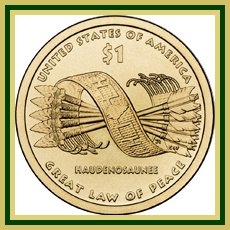 2010 Native American $1 Coin
2010 Native American $1 Coin
The theme for the 2010 Native American $1 Coin is "Government—The Great Tree of Peace." Its reverse design features an image of the Hiawatha Belt with 5 arrows bound together, along with the inscriptions UNITED STATES OF AMERICA, $1, HAUDENOSAUNEE and GREAT LAW OF PEACE.
Great Tree of Peace (early 1400s)
(Noted in P.L. 110-82 as "Iroquois Confederacy")
The Haudenosaunee Confederation, also known as the Iroquois Confederacy of upstate New York, was remarkable for being founded by 2 historic figures, the Peacemaker and his Onondaga spokesman, Hiawatha, who spent years preaching the need for a league. The Peacemaker sealed the treaty by symbolically burying weapons at the foot of a Great White Pine, or Great Tree of Peace, whose 5-needle clusters stood for the original 5 nations: Mohawk, Oneida, Onondaga, Cayuga and Seneca.
The Hiawatha Belt is a visual record of the creation of the Haudenosaunee dating back to the early 1400s, with 5 symbols representing the 5 original Nations. The Haudenosaunee symbol, the Great White Pine, is the central figure on the belt, also representing the Onondaga Nation. The four square symbols on the belt represent the Mohawk, Oneida, Cayuga and Seneca nations. The bundle of 5 arrows symbolizes strength in unity for the Iroquois Confederacy.
Northern European settlers from France, England and the Netherlands interacted with the Haudenosaunee as a separate diplomatic power. The success of the confederation showed the colonists that the Greek confederacies they had read about in the histories of Polybius were a viable political alternative to monarchy. The symbolism of the Great Tree of Peace and eagle sitting on its top were adopted as national icons during the American Revolution.
Background: Government
Some early narratives by explorers and missionaries introduced Europe to Native American societies which practiced equality and democratic self-government. These narratives quickly found their way into classics of European thought, including Sir Thomas More's "Utopia" and Montaigne's "Essays." John Locke cited the Huron election of its chiefs in his refutation of the Divine Right of Kings.
When the newly independent Americans devised a continental government, they may have seen in these native societies living examples of the successful confederacies that they admired in the ancient Greek histories. Many tribal groups established confederations often based on linguistic affinity. One of the most famous and powerful of these Native leagues was the Iroquois Confederacy, known to its members as the Haudenosaunee (People of the Longhouse) or the Six Nations.

The Importance of the Wampum Belt in Negotiations / Trade / Treaties
The importance placed on negotiations with the Native American Indians was even recorded in an engraving depicting a Grand Sachem and a Tribal Council. The same gravity would be accorded to negotiations between the tribes and the French and English setters.
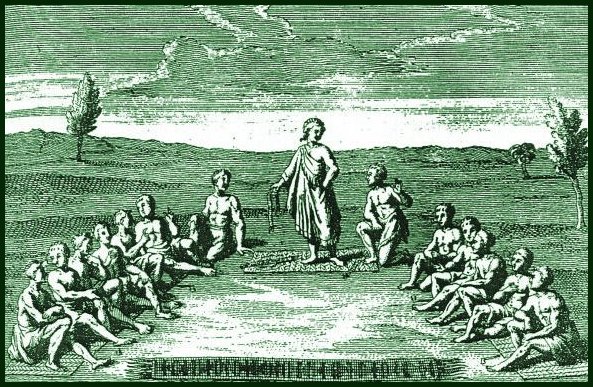

A Grand Sachem at the centre of a crescent-moon maweomi with a Covenant Chain wampum belt in the foreground, a symbolic element that bound the Grand Council together.
From Moeurs des Sauveges Ameriquains, Joseph Francois Lafitau, 1724 - (Courtesy of the Quinnipiac Tribal Council)

As the Huron tribe features so prominently from this point on it is interesting to note that there is in existence a Huron Wampum Belt commemorating the 1683 agreement between the Hurons and the Jesuits!
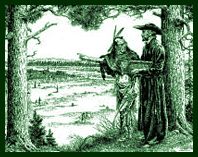

The Huron Wampum Belt commemorates the 1683 agreement between the Hurons and Jesuit missionaries for the construction of the first wooden church on Huron Lands. Adapted from The Native Americans. Edited by B. & I. Ballantine. 1993
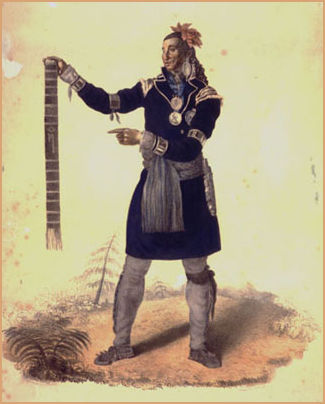
Nicholas Vincent Isawahoni, a Huron Chief, holding a wampum belt, 1825
Even if colonial or subsequent Dominion governments were unwilling or unable to do so, Aboriginal groups steadfastly retained the knowledge of their unique relationship with the Crown during peace and war throughout the 19th century into the 20th century and beyond. Library and Archives Canada (C-38948) - Image and strapline information sourced from - forces.gc.ca
Page refreshed : 23rd July 2020 (G)

